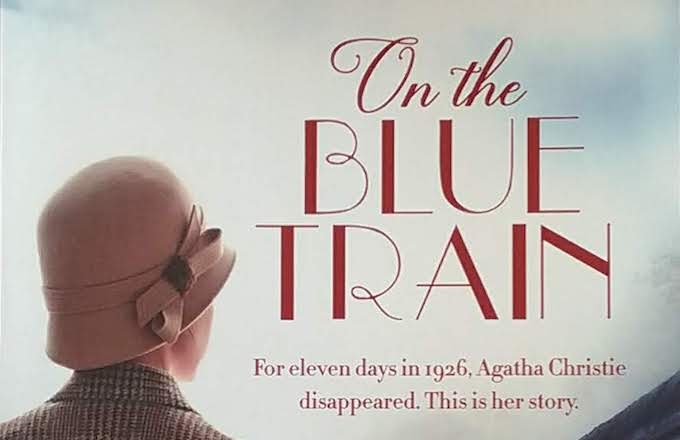12+ Kristel Thornell’s On the Blue Train is a novelisation of the eleven days in 1926 when — in a mystery worthy of Poirot — Agatha Christie disappeared. The novel opens with Agatha outside Harrods. She is confused and cannot enter the store, unable to "even recall what she needed to purchase".
A lady brushes past, "all polish and ease", and Agatha catches her name, "Teresa". She follows the "magnetic" lady into Harrods and trails her discreetly, "trying some of her gestures, which were wonderfully collected and free of anxiety".
When Agatha completes her business and is asked for a delivery address, she hesitates before replying, "The Harrogate Hydro", remembering an advertisement she has seen. And when asked for a name, Agatha responds firmly, "Teresa Neele", assuming the magnetic lady's first name and the surname of her estranged husband's lover.
Agatha is now Teresa, one of the guests "taking a cure" at the Harrogate spa town hotel. She is befriended by the elderly Mr and Mrs Jackman, who sympathise with Teresa’s story of losing her husband and baby daughter. Teresa also meets Harry McKenna, an Australian widower similar in age to her, whose wife’s inheritance has left him wealthy but lonely.
The Mystery of the Blue Train
Before reviewing On the Blue Train for Writing NSW, I had not read an Agatha Christie. I am familiar with her mysteries, however, and Thornell's book had all the ingredients: a famous person, a disappearance, a grand hotel, well-heeled guests. Her narrative and dialogue were formal, too. I reasoned Thornell had chosen the style to reflect the class and times of the characters or perhaps to pay homage to Christie's writing.
So I put the book aside and read The Mystery of the Blue Train (1928), the Poirot novel that Christie wrote when she disappeared. Christie struggled with this book before and after her disappearance. And in her self-titled autobiography (Collins 1977), she confessed:
"I have always hated The Mystery of the Blue Train, but I got it written, and sent off to the publishers. It sold just as well as my last book had done. So I had to content myself with that — though I cannot say I have ever been proud of it."
Christie populates her “hated” novel with stereotypical well-to-do protagonists. But as Kate Evans observed in her BooksPlus interview with Thornell in 2016 (ABC Radio National, October 2016), it is “almost entirely plot-driven”, with “little interior life”, whereas On the Blue Train is “literary and interior”. Thornell revealed in the interview she had tried to capture the “comforting atmosphere and flow” of Christie’s detective genre but in a setting where the “mystery was entirely an internal one”.
LOVE WRITING REVIEWS?
Share and showcase your reviews and other writing — fiction and nonfiction — as a Guest Writer on Tall And True.
On the Blue Train
I returned to Thornell’s novel and soon became immersed emotionally in her well-crafted storyline and characters. Away from Harrogate, thousands join the search for Christie, and newspapers publish her photo on their front pages. Meanwhile, with each passing day of seclusion, Teresa’s health and confidence slowly recover, buoyed by the curative effects of the spa town and by her growing friendship with Harry.
Christie makes no mention of Harrogate in her autobiography. In the opening of the chapter on 1926, she merely comments:
"The next year of my life is one I hate recalling. As so often in life, when one thing goes wrong, everything goes wrong."
And in closing the chapter:
"After illness, came sorrow, despair and heartbreak. There is no need to dwell on it."
As Christie never addressed this episode, novelists have blended fact with fiction to imagine an explanation. And Thornell has done so beautifully with On the Blue Train. Although I knew the outcome for Christie, as the novel neared the end of her final days at Harrogate, I willed Teresa to choose a different path.
Allowing the reader to suspend disbelief is surely the gift of a good book.
© 2018 Robert Fairhead
Note: You may also be interested in my work-in-progress review of Thornell's On the Blue Train on Tall And True, titled Agatha Christie's "Blue Year" (August 2018).
This book review was originally published by Writing NSW in October 2018.
Robert is a writer and editor at Tall And True and blogs on his eponymous website, RobertFairhead.com. He also writes and narrates episodes for the Tall And True Short Reads storytelling podcast, featuring his short stories, blog posts and other writing from Tall And True.
Robert's book reviews and other writing have appeared in print and online media. In 2020, he published his début collection of short stories, Both Sides of the Story. In 2021, Robert published his first twelve short stories for the Furious Fiction writing competition, Twelve Furious Months, and in 2022, his second collection of Furious Fictions, Twelve More Furious Months. And in 2023, he published an anthology of his microfiction, Tall And True Microfiction.
Besides writing, Robert's favourite pastimes include reading, watching Aussie Rules football with his son and walking his dog.
He has also enjoyed a one-night stand as a stand-up comic.


 Browse & Buy on Amazon.com.au
Browse & Buy on Amazon.com.au


